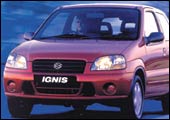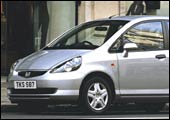| THE NEW LINE UP |
What's B+?
For our purposes, it's a car smaller than,
say, the Ikon, but more expensive than the Santro or Zen. |
 |
MARUTI IGNIS
Engine:
Petrol: 1,298-cc (85 bhp)
Expected launch: 2003
Expected price: Rs 4-5 lakh
Maruti's model D has been waiting in the wings for a while.
Launch plans not confirmed. Rugged SUV looks and fuel-efficient
engines a big plus, but interiors short on space compared to
rivals. |
 |
FORD FUSION
Engines:
Petrol: 1,597-cc (91 bhp)
Diesel: 1,753-cc (90 bhp)
Expected launch: Jan 2004
Expected price: Rs 5-6 lakh
SUV looks on a mid-size car platform is what makes the Fusion
unique. Expected with both petrol and diesel engines and a seven-seater
option. |
 |
HYUNDAI GETZ
Engines:
Petrol: 1,086-cc (62 bhp), 1341-cc (82 bhp), 1,594-cc (105bhp)
Diesel: 1,493-cc (80 bhp)
Expected launch: June 2003
Expected price: Rs 4-5 lakh
Essentially aimed at Europe, Getz's wide range of engines in
India (both petrol and diesel) should make it a winner. Generous
on internal space. |
 |
DAEWOO MATIZ
Engines:
1,000-cc-1,200-cc (60-70 bhp)
Expected launch: 2005
Expected price: Rs 3-4 lakh
New Daewoo models likely to come into India with GM, but not
badged as Daewoo. New generation Matiz-codenamed M200-could
come in badged as Chevrolet. 3-way partnership of GM-Suzuki-Daewoo
makes this a strong possibility. |
 |
HONDA FIT
Engines:
Petrol: 1,493-cc (106 bhp)
Diesel: 1,343-cc (90 bhp), 1,493-cc (100 bhp)
Expected launch: Dec 2003
Expected price: Rs 5-6 lakh
This three-box version of the popular Jazz should come to India
with over 70 per cent local content. Very cleverly designed
interior. |
Ask
any Motown Hamlet, and he'll tell you that to B or not to B is not
really the question any more. The foreign car majors have been around
in India for as long as seven years and they've tried every trick
in the book to sell their big cars, but things just don't seem to
be working out. A staggering 80 per cent of the cars sold carries
a price tag of Rs 4 lakh or less, and two companies alone-Hyundai
and Suzuki, midgets compared to their Detroit rivals-account for
almost seven of every 10 cars sold.
So the others have just two options: One, wait
for the day when the smallest car sold would be, say, the Ford Ikon,
but until then watch Hyundai and Suzuki eat their lunch or, two,
rummage through their global portfolios and find a car that is small
enough to fit the Indian consumer's pocket. Not surprisingly, it's
the second option that is getting exercised. Over the next 14 months,
some six cars, priced between Rs 4 lakh and Rs 6 lakh, are to debut
in the market. These include the Hyundai Getz, Honda Fit, Suzuki
Ignis, Ford Fusion, Toyota Vitz, and-don't laugh-the next generation
Daewoo Matiz.
All these cars will be positioned in the new
segment-called B+ in industry-speak-created by the entry of Fiat
Palio. Like the Italian global car, the new line up will be smaller
than mid-size cars like the Opel Corsa or Ford Ikon, but more expensive
than the popular Santros and the Zens. Says Maurizio P. Bianchi,
Chairman and Managing Director, Fiat India: "India is a price-conscious
market and this segment offers the best value for money." Adds
B.V.R Subbu, President, Hyundai Motor India: "There is bound
to be a lot of action in B+, and it will grow."
Mass Appeal
That's precisely the point. Every one expects
India to remain a small car market for a long time to come. In fact,
a study conducted by Maruti Udyog indicates that in a growing market,
it is the dominant segment that grows faster. Top executives at
the market leader point to Mexico as an example. In 1998, they say,
the total car market in Mexico was 6.40-lakh big, and small cars
made up 48 per cent. Today, 8.40 lakh cars are sold in Mexico, and
the share of small cars has jumped to 59 per cent. And the bet is
that India will go the Mexican way. Says Jagdish Khattar, Managing
Director, Maruti Udyog: "With a strong possibility of the economy
improving, construction of better roads, cheaper car finance, and
a clear government intent on lower excise duties, I see the car
market growing at a healthy pace."
Khattar isn't the lone optimist. Executives
in Honda Siel Cars expect the B segment to grow at 10 per cent annually
over the next two to three years. According to the company's General
Manager (Marketing), Ananda Mohan Gupta, 85 per cent of all cars
bought over the next five years could be small cars, with the B
segment making up for 65 per cent. Others like Rajiv Dube, General
Manager (Commercial Passenger Cars), Tata Engineering, see the market
growing to 1 million units a year (from 6 lakh today), provided
taxes on cars are lowered. Today, nearly 55 per cent of the price
of a car is made up of various taxes.
The industry's recent history seems to corroborate
the argument for small cars. According to David Friedman, Managing
Director, Ford India, the average spend on cars has moved up by
25 per cent over the last four to five years. And the definition
of-and consumer expectation from-a small car is changing too. Not
long ago, the Maruti 800 epitomised the entry-level small car. When
the Zen came, a lot of buyers graduated directly to it. This trend
intensified with the coming of Santro. Ergo, since 1998, the share
of B-cars has been growing-from 27 per cent to 57 per cent in January-August
2002. According to BT estimates, based on ncaer's automotive demand
projections, that share could well soar to 70 per cent in 2005-06.
That's a forecast car marketers don't want to
ignore. Honda Siel, for instance, has begun work on a small car,
Fit, which is the Asian version of a popular model in Japan called
Jazz. Fit, also to be launched in Thailand, will have 70 per cent
local content, and the vendors have been told that the car has to
roll out by September 2003. According to another vendor, Honda also
plans to launch a 660-cc car sometime in 2004-5. Apparently, Honda
currently does not have this platform and, therefore, is developing
the engine. Honda wouldn't confirm any of it. Says Honda's Gupta:
"Honda has no immediate plans of introducing a small car. We
have established ourselves in the C segment, and wish to become
the No. 1 player in the premium segment."
Similarly, Toyota Kirloskar refused to comment,
but some of its vendors say that the company is working on three
independent projects at the moment: the 1496-cc petrol and 1794-cc
diesel Corolla, a small car Vitz, and the Euro III variant of Qualis.
Work on Vitz, BT learns, is at a fairly preliminary stage. Interestingly,
General Motors too is expected to foray into small cars with a new
generation Daewoo Matiz, currently under development. The new car
is likely to come under a new marque for India-possibly Chevrolet.
gm India, however, isn't revealing anything. "As of today,
we have no plans to enter the small car market," says a company
spokesperson. "However, we are open to business opportunities
and have our alliance partnerships in place for the purpose."
Besides these, Volkswagen-it launched its resurrected
Czech brand, Skoda, in India in November 2001-is contemplating setting
up a manufacturing base in India. According to a Skoda official
in Delhi, VW executives have made as many as five visits to India
in the recent past. "They are closely studying the Indian market
and would take a decision on investing in India shortly," says
the Skoda executive. The Rajasthan government is believed to have
offered VW land, but the company is weighing other options. VW offerings
in India could include the Polo and the Passat.
 |
Jagdish Khattar: MD,
Maruti Udyog |
| "With a strong possibility of the economy
improving, construction of better roads, and cheaper car finance,
the car market should grow" |
Think Global, Make Local
For most of these players, another model should
make their local operations that much more viable. Most of them
set up manufacturing facilities expecting higher volumes. Therefore,
few need to spend any substantial amount of money on new models.
Small investment, then, should help them make money even if volumes
are small. Says Friedman: "Most of our investment is in place
and introducing a new model should cost us anything between Rs 10
crore and Rs 50 crore, depending on the model and its volumes."
A bigger product portfolio helps in another
important way. It gives suppliers much-needed volumes, allowing
them to make components cheaper, and thus setting the stage for
greater localisation of components. And almost nobody in the industry
today thinks that car-makers can get by importing kits. That's simply
because, apart from the logistics of it, the rupee keeps depreciating
every year, either making the kits costlier or squeezing margins.
 |
| David Friedman, CEO, Ford India |
| "Our investments are in place and introducing
a new model should cost us Rs 10-50 crore" |
In the recent past, it's the Fiat Palio that
may have helped the industry make up its mind. The car was launched
in September 2001 only after the supply for three-fourths of its
components had been tied up locally. Today, the Palio boasts of
85 per cent local content. Says Fiat's Bianchi: "We could have
launched the Palio earlier, but it made sense to wait for greater
localisation and launch it at a lower price point."
That will likely be the preferred strategy of
the others too. In fact, Friedman declares that any new car from
Ford in India will be manufactured locally. For example, vendors
for Ford Fusion-whose launch Friedman refused to confirm or decline,
saying that "we can't talk about the specifics of our future
models"-have already been alerted, although, according to one
vendor, Ford is yet to begin work on the engine of this car.
Yet, it's a no-brainer that in a market like
India, car-makers will need to figure out ways to make money by
selling smaller volumes of many different models. Some of them will
crash out of the race, but the others will stay on the winning course.
In any case, one man is already winning the automotive grand-prix:
the consumer.
|

